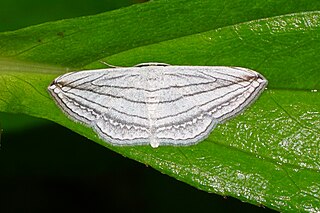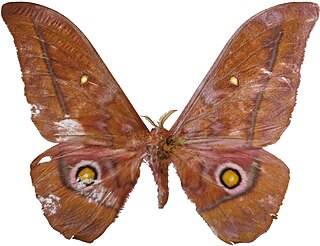Related Research Articles

Polyptychus affinis is a moth of the family Sphingidae first described by Walter Rothschild and Karl Jordan in 1903. It is known at elevations up to 6,000 feet (1,800 m) in forests from Sierra Leone to the Congo, Uganda and western Kenya.

Rhodometra sacraria, the vestal, is a moth of the family Geometridae. The species was first described by Carl Linnaeus in his 1767 12th edition of Systema Naturae.
Exelastis montischristi is a species of moth in the genus Exelastis known from Hispaniola, Ecuador, Grenada, Jamaica, Martinique, the Virgin Islands, Florida and Texas. It has also been recorded from Tanzania.
Basiothia medea, the small verdant hawk, is a moth of the family Sphingidae. It is common in open habitats throughout the Ethiopian Region, including Madagascar. It is however probably absent from the equatorial forest belt, except as a vagrant. The species is an active migrant.

Theretra capensis is a moth of the family Sphingidae. It is known from woodland and open habitats from the Cape to Zimbabwe, Zambia, Democratic Republic of the Congo, Malawi, Mozambique and East Africa.

Achyra massalis, the ombava, is a moth of the family Crambidae. The species was described by Francis Walker in 1859. It is found in most of the Old World tropics, including Réunion, Namibia and Australia.

Hypotia saramitoi is a species of snout moth in the genus Hypotia. It was described by Christian Guillermet in 1996 and is known from Réunion.

Decachorda is a genus of moths in the family Saturniidae. The genus was erected by Per Olof Christopher Aurivillius in 1898.

Scopula opicata is a moth of the family Geometridae first described by Johan Christian Fabricius in 1798. It is found in tropical Africa, including Malawi and Zambia, as well as in Sri Lanka, India, China (Hainan), Myanmar, Sundaland, the Philippines, Sulawesi, Timor and New Guinea.
Glyphodes boseae is a moth of the family Crambidae. It was described by Max Saalmüller in 1880 and it is found in Madagascar.

Banisia myrsusalis, the sapodilla borer or sapota midrib folder, is a species of moth of the family Thyrididae. It was described by Francis Walker in 1859 and is found in North America, Brazil, Australia, southern Asia and Africa.
Urapteritra falcifera is a moth of the family Uraniidae first described by Weymer in 1892. It is found in eastern Africa and South Africa.
Rhypopteryx rubripunctata is a species of moth of the subfamily Lymantriinae first described by Gustav Weymer in 1892. It is known from the Democratic Republic of the Congo, South Africa and Tanzania.
Striginiana agrippa is a moth of the family Eupterotidae. It can be found in Tanzania.
Bunaeopsis phidias is a moth of the family Saturniidae. It is known from Africa, including Tanzania, Eritrea, Malawi and Zambia.
Nudaurelia richelmanni is a moth of the family Saturniidae. It is known from Tanzania.

Nudaurelia xanthomma is a moth of the family Saturniidae. It is known from Cameroon, Ghana and Sierra Leone.
Syllepte attenualis is a moth in the family Crambidae. It was described by George Hampson in 1912. It is endemic to Kenya.
References
- ↑ De Prins, J. & De Prins, W. (2018). "Decachorda pomona (Weymer, 1892)". Afromoths. Retrieved November 12, 2018.
- ↑ (in German) Weymer, G. W. 1892. Exotische Lepidopteren VI. Aus dem Afrikanischen Faunagebiet. Stettiner Entomologische Zeitung 53(4–5):113